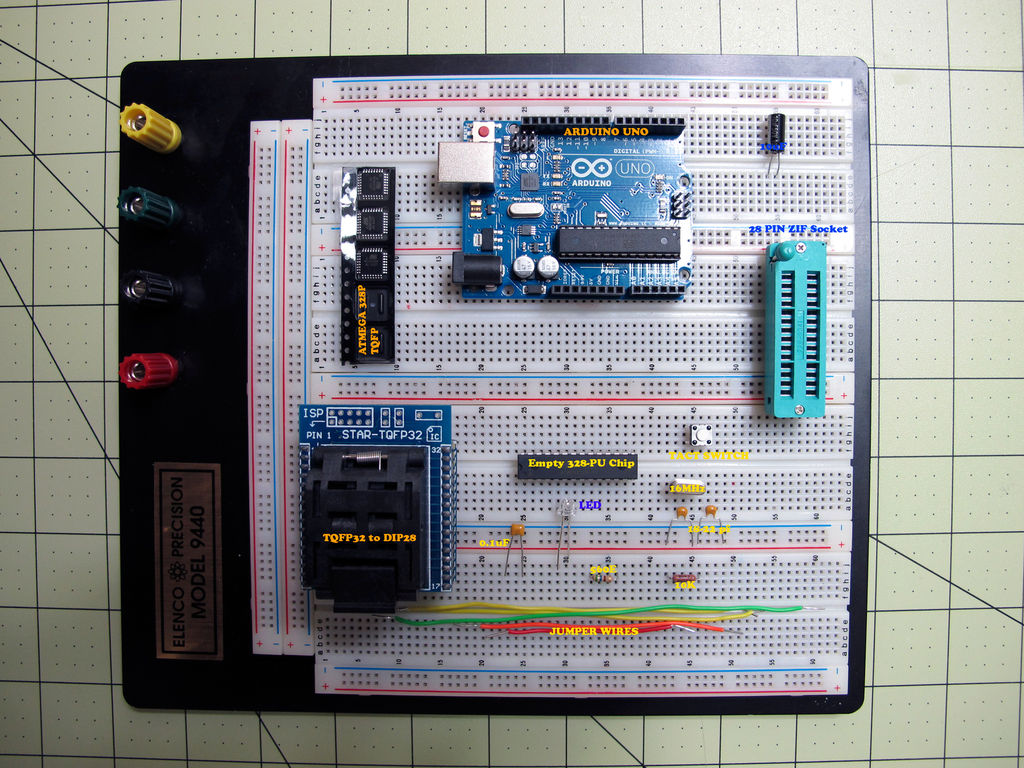Parts required (Hardware)
- Arduino Uno Board (1)
- TQFP 32 to DIP 28 Adapter (1) Link
- Atmega TQFP 32 pin chip (1)
- Atmega DIP 28 pin chip (1)
- 10K resistor (1)
- 16MHz crystal (1)
- 18pf – 22pf capacitor (2)
- Tact Switch (1)
- Jumper wires (few)
- LED (1)
- 560 Ohm resistor (1)
- 10uF electrolytic cap (optional)
- Breadboard (1)
- Arduino Pins (2×6 pins, 2×8 pin socket)
- ZIF socket 28 pin (1)
Software pre-requisites : Arduino software installed
If you like this Instructable. I greatly appreciate your Vote for this Instructable @ http://www.instructables.com/contest/123dcircuits…
Thank You
Step 1: Burn Arduino ISP to Arduino board
Connect Arduino Uno board to your computer. Start Arduino program and from examples choose “ArduinoISP” sketch and upload it to “Arduino Uno” board. Please make sure you select the correct board name and serial port. Now this board is ready to program new Atmega-328 chips on the breadboard as shown in the next step.
Step 2: Arrange all components on breadboard
Wire all components as shown in this picture on the breadboard. The Ziff socket is placed starting on pin 21, Add markings on the Breadboard to show Pin 1, Pin 14, Pin 15, Pin 28 of Atmega dip28 chip as it will be easy to wire later. The Breadboard does not show power, But run power +5V and GND from breadboard to Arduino board.
Step 3: Update Signature inside avrdude conf file
It is recommended to first test burn bootloader on a Atmega 328 DIP-28 chip. I have Atmega 328-PU chips which requires signature to be updated inside avrdude conf file as shown in the picture.
Please make a backup of avrdude file and copy it so original file is left untouched and you can fail back to it if required. This file can be found under “C:\arduino-1.0.1\hardware\tools\avr\etc\avrdude”.
Please restart Arduino program after you update “avrdude” config file.
The “#” sign in from of the signature indicates comment (not used by arduino)
Step 4: Burn Bootloader to Atmega-328 DIP chip
Step 5: Placing the Chip in TQFP Adapter
Connect 8 pin, 6 pin sockets as shown to DIP28 pins of TQFP adapter. This is to raise it on breadboard and to have a good view of pins on the breadboard. Please pay close attention to Electro Static Discharge which can damage the chip when loading and removing it from the socket. Align the pins of the chip as shown in the picture.
For more detail: Burn Arduino Bootloader on Atmega-328 TQFP and DIP chips on Breadboard


